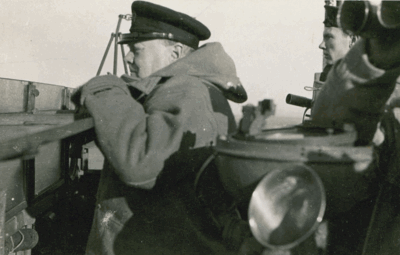On May 1st 1942 the Tribal Class Destroyer HMS Punjabi was part
of a screen of destroyers on the flanks of a line of capital ships
that included the battleship HMS King George V, the Carrier HMS
Victorious, the battleship USS. Washington, and the Cruisers USS.
Wichita and USS. Tuscaloosa. The force was covering P.Q.15 on its way to Murmansk in Russia
with vital materials for our ally in the fight against the Nazi's. I
was a telegraphist aboard Punjabi, and my job was to intercept
German Morse Code signals on high-frequency direction finding
equipment . "HMS Punjabi" (Wright
& Logan - Southsea)
We had left Iceland
five days before and were in Arctic waters when at 15:45 on May 1st
a thick fog descended on the fleet. I was in the main wireless cabin in the forward part of the ship, prior to
relieving another telegraphist in the cabin aft where we conducted
our interception work. Suddenly there was a tremendous crash, the
Punjabi heeled over sharply on its side, and all the lights went
out. First thought was that we had been torpedoed, but our nemesis
turned out to be one of our own ships - the 34,000-ton battleship
King George V had rammed and cut in half our 1,850-ton destroyer.
"HMS King George V",
anchored in Seydisford, Iceland before returning to Liverpool for
repairs.
|
||||||||||||||||||||||||||||||||||||||||||||||||||||||||||
|
Two old
sailors meet for the first time 65 years after their two
ships were involved in one of the more unusual events of
World War II. On the left is Seniors Voice writer Ken
Tipper, and on the right is Albert Ward, who lives in
Wales. On May 1, 1942, Tipper was aboard the Royal Navy
destroyer HMS Punjabi, and Ward was aboard the
battleship King George V. Their ships were part of an
Allied fleet protecting a convoy to Russia. In a thick
fog, while the fleet was well inside the Arctic Circle,
the 35,000-ton King George V rammed and cut in half the
1,780-ton Punjabi. The destroyer sank in 45 minutes, and
by a miracle, despite the freezing water and the
casualties caused by the collision, 201 of the
250-member crew were saved. The picture was taken at the
Ocala-Marion Veterans Park with a plaque commemorating
the battleship USS Washington, which on that fateful day
barely avoided a collision with the sinking destroyer.
The two old sailors met through a letter Tipper wrote to
the Royal Navy newspaper, “Navy News”, asking for anyone
who was involved in the incident to contact him. |

"Home" is in Florida.
I am father of two, grandfather of five. We are now
great-grandparents to Elias Gregory, our first boy, who was born in
November. So we now have five great-grandchildren. And of course I
am now 85! Tempus fugit!!!with my wife of 60years to share our
memories.

|
Roll of Honour - In Memoriam |
|
|
Barry AM. Surg.Lt RNVR |
Owens John/ AB |
|
Black James. A/B |
Piggin SF. Sub. LT RNZNVR |
|
Brock Thomas W. O/Sea |
Phillips Maurice PO.Stwd |
|
Bruce William A. L/Sto (Ty) |
Preston Theodore L/Stwd |
|
Carmock William.Ck(O) |
Pryse Idris G. O/Sea |
|
Cook Tom O/Sea |
Quin John B. O/Sea |
|
Daniels Albert Stwd |
Rigby Arthur O/Sea |
|
Douglas Stanwyn Tel RNVR(W) |
Roberts Clarence ET.LAB |
|
Farr Lawrence B SBPO |
Scott Collin F. O/Sea |
|
Farrance Edward O/Sea |
Shotton Harold Ass. Ck(O) |
|
Finch William G.
Sto. RFR |
Stiff Arthur J. L/Tel R.FR |
|
Ford William J. A/LSea |
Thomas William I. O/Sea |
|
Hadden William T. Sto1 |
Trenouth Leslie H. Ch.ERA2 |
|
Harbottle JW Lt. |
Trotman Alfred E. AB |
|
Irwin John J. O/Sea |
Smellie HW. Sub. Lt. RNVR |
|
Lloyd Dennis H A/B |
Summers EJ. Mid. RNR |
|
McDonald Edward Sto1 |
Vernon Roy CV O/Sea |
|
McGugan Andrew Boy1 |
Vintcent LA. Lt.Cdr.(E) RN. |
|
McKinley Alexander K. Sto1 |
Walmsley Richard Sto 2 |
|
McMullin Sidney O/Sea |
Ward Daniel Sto 1 |
|
McNaughton DH. Ty Act. S.Lt
RNVR |
Watchorn Richard A O/Sea |
|
McNaughton Thomas O/Sea |
Watson
Frederic W. Ass. Stwd |
|
Middleton Albert T. A/B |
Williams William L/Stwd(Ty) |
|
Neave Ernest W A/B. |
Wynne Dennis Sto 1 |
|
Neilson William A/B. |
|
Copyright: Kenneth Tipper










